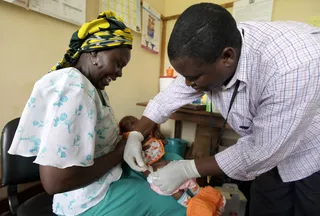World Malaria Day 2012
Learn more about the global fight against malaria.

1 / 8
World Malaria Day 2012 - World Malaria Day, April 25, is a global day of observance on the worldwide effort to provide effective control of malaria.According to the World Health Organization, or WHO, in 2010, malaria caused an estimated 216 million illnesses and 655,000 deaths, mostly children under 5 years old in Africa. On this day, the World Health Organization urges affected countries to support each other’s efforts in combating the disease, for donors to step forward and become involved in malaria prevention, and for researchers and scientists to present their latest findings in relation to malaria eradication. — Naeesa Aziz(Photo: EPA/DAI KUROKAWA/Landov)

2 / 8
“Sustain Gains, Save Lives: Invest in Malaria” - This year’s World Health Day slogan, “Sustain Gains, Save Lives: Invest in Malaria,” calls for greater participation in the battle against malaria, but also acknowledges the great strides that have been made in malaria prevention over the past decade.\r \rAccording to WHO, Africa has seen a one-third reduction in malaria deaths over the last decade, and outside of Africa, the 35 countries affected by malaria have reduced cases by 50 percent. In places where malaria control interventions have become readily available, overall child mortality rates have fallen by nearly 20 percent.\r\r(Photo: Simon Akam/Landov)

3 / 8
Test, Treat, Track - \r \r \r \rAs with many other public health epidemics, testing and monitoring of the sick is key to understanding how to stop the spread of the disease. This World Malaria Day, WHO is urging governments not to forget this important component of malarial control. The agency urges countries hit hardest by malaria to move toward universal access to diagnostic testing and antimalarial treatment, and to build robust malaria surveillance systems.\r \r“Until countries are able to test, treat and report every malaria case, we will never defeat this disease,” said Dr. Margaret Chan, WHO Director-General. "We need strong and sustained political commitment from all countries where malaria is endemic, and from the global health community, to see this fight through to the end.”\r\r(Photo: REUTERS/Joseph Okanga)\r\r
Photo By Photo: REUTERS/Joseph Okanga

4 / 8
What Is Malaria? - \rMalaria is a completely preventable and curable, yet life-threatening disease, which affected nearly 216 million people worldwide last year alone.\r \rThe disease is caused by parasites that are transmitted to humans through bites from infected mosquitos. Once infected with the parasites, symptoms of illness begin to appear within seven days or more. Infected humans experience fever, headache, chills and vomiting, which can progress to severe illness if left untreated for more than 24 hours. Malaria’s stronghold on Africa has been bolstered by a lack of infrastructure in many places (especially rural areas) where open ditches and other standing pools of water create the perfect breeding ground for mosquitoes.\r \r \r(Photo: EPA/STEPHEN MORRISON/Landov)

5 / 8
Why Don’t We Get Malaria in the U.S.? - Malaria was declared eradicated in the United States in 1949 after the government adopted an aggressive program, which included spraying affected areas with insecticides and the removal of mosquito breeding sites.(Photo: Dan Currier/ Getty Images)
ADVERTISEMENT

6 / 8
Why Are Children So Susceptible? - In places where malaria occurs most frequently, many adults develop a partial immunity to the malaria parasites over years of exposure. Young children who are unfortunate enough to contract the disease simply have not had time to build up any immunity. In Tanzania, 80 percent of all malaria deaths occur among children under age 5. (Photo: Spencer Platt/Getty Images)

7 / 8
Nothing but Net? - Despite heavy reliance on insecticide treated malaria nets as a means of reducing malaria transmission, heavy criticism has surfaced that the nets are a not-so-useful Band-Aid for a larger problem that can only be addressed by improved infrastructure. Further maligning the nets is a recent study from Senegal that shows many mosquitoes have become immune to the treated nets and are still managing to have damaging effects on public health. (Photo: Spencer Platt/Getty Images)
